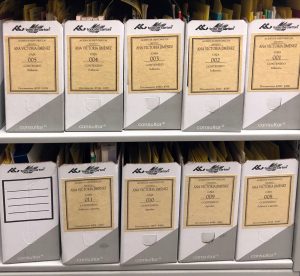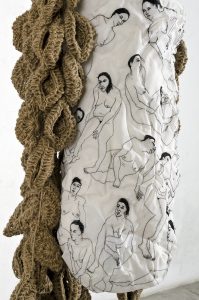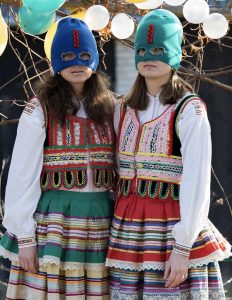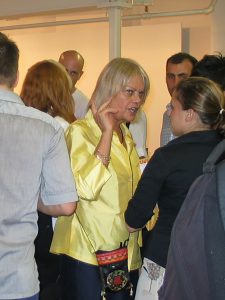Peggy Ahwesh at Microscope Gallery
By Yohanna M. Roa

Peggy Ahwesh. The Wayfinders, 2025. Exhibition view. 5-channel video installation, floor fans, sound. Dimensions variable. Edition of 5 + 2 APs. “The Wayfinders” Credits: Nico Cadena (Pilot & Flight Tech); Grey Gersten (Composer); Marianne Shaneen (Writer); Mohammad Balaweh (Sound Artist); Ben Coonley (Technical Assistance); Keith Sanborn (Technical Assistance).
Photo, Courtesy of the artist and Microscope Gallery, New York
Peggy Ahwesh’s The Wayfinders unfolds as a space of tension and resonance, where ruin and simulation converge to generate a complex apparatus for experience and reflection. Presented at Microscope Gallery, the installation centers on the abandoned Qalandia/Atarot airport, located between the town of Qalandia and Jerusalem, a site deeply marked by political and geopolitical transformations. Rather than merely reconstructing the airport through Flight Simulator 2004: A Century of Flight, Ahwesh transforms it into a counterhistorical terrain, a site where official narratives can be deconstructed, rewritten, and compelled to operate against their own authority.
Inserted within this critical landscape, the work foregrounds history as a political and colonial construction, dismantling Western historiographic methodologies grounded in linearity, closed archives, and singular temporality. Instead of aligning itself with a Western trajectory, The Wayfinders emerges as a non-Western practice that questions hegemonic modes of narrating the past and proposes, in their place, multiple temporalities and ontologies. Ruin—recovered, inhabited, or simulated functions as an epistemic device that refuses to fix the past, opening it instead to speculation, affective memory, and present reconfiguration.

Peggy Ahwesh. Detail, The Wayfinders, 2025. Photo, Courtesy of the artist and Microscope Gallery, New York
Digital simulation operates as a porous counterarchive. Through the simulator, Ahwesh shifts documentary authority away from institutions and toward forms of knowledge born from the friction between personal memory, material residues of conflict, and ancestral systems of stellar navigation. In this sense, the work places the notion of the finished artwork in crisis, unsettling the archive as a rigid structure and proposing a performative historiography in which the past activates and transforms itself in real time.
Ruin and simulator operate as conceptual and epistemological axes structuring the work not simply as motifs, but as devices that shape the spectator’s encounter. Ruin appears not as a closed or completed past, but as an interruption of meaning: a suspended, open zone where time and history fracture and invite reimagination. Inactive runways, a dilapidated control tower, and the remnants of successive conflicts function as traces of discontinuous temporality, a living archive whose preservation or erasure is inevitably political. In this sense, Ahwesh renders ruin an active territory charged with tension, narrative possibility, and ethical implication.
The simulator, in turn, operates as a mechanism of counterhistory. It does not merely reproduce spatial trajectories between Beirut, Damascus, and Jerusalem; it generates temporal and conceptual dislocations that connect distinct historical moments, expose hidden layers of meaning, and displace the spectator from chronological linearity into a multifaceted, embodied experience. Each flight whether a daylight journey skirting the coast from Beirut to Damascus; a southern flight from Beirut where clear skies thicken into a storm over a ruined landscape suggestive of Gaza; a nocturnal approach from Qalandia/Jerusalem toward the Old City; a daytime round trip between Qalandia/Jerusalem and Damascus; or a route guided solely by the night sky and constellations drawn from ancient Arabic star lore creates a bridge between the real and the imagined, between ancestral memory and contemporary experience, rendering history a living archive that simultaneously activates and interrogates dominant narratives.
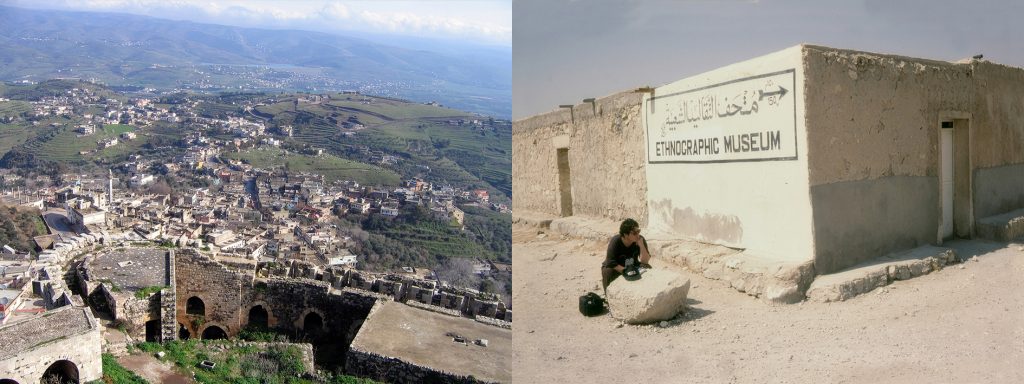
Peggy Ahwesh. View of Habnemra / Ethnographic Museum. 2006/1990/2025. Archival pigment print. 18 1/2 x 43 1/2 inches (framed) Edition of 3 + 2 APs
Ahwesh positions herself as both narrator and agent. Her body and her voice articulated through the videogame, the flights, and the representation of place actively mediate the viewer’s encounter with history. Standing before an ethnographic museum and alongside now-lost Syrian archaeological ruins, she forges a direct link to ancestral memory and the broader civilizations of the region. Flying within the simulator becomes an embodied gesture that acknowledges displacement and reanimates ancestral knowledge, where constellations such as Capricornus, Pherkad, and Kochab operate as mnemonic maps and poetic tools for orientation. As the writer of the poetic voiceover that accompanies the installation, Marianne Shaneen articulates this temporal and affective layering with striking clarity:
“Looking up a mother in Gaza tries to touch the blue / she conjures imaginary departure times / printed like magical incantations on a boarding pass.”
These lines underscore how the installation traces itineraries that are simultaneously geographic, historical, and affective, binding imagination, memory, and the materiality of ruin.
The work unfolds across multiple intersecting layers. On one level, it depicts bodies moving through the abandoned airport: women and children navigating a ghostly space that has remained inactive for twenty-five years. On another, projected constellations connect their trajectories to ancient travelers whose knowledge of navigation, astronomy, and geography resonates across centuries. This superimposition produces a productive dislocation, allowing viewers to perceive history as a complex fabric of memories, knowledge systems, and social tensions spanning civilizations.
By selecting an obsolete digital simulator, Ahwesh introduces a double displacement: she reconstructs a no-longer-operational airport with a technological ruin. Programmed physics, interpolated geographies, and artificial atmospheres do not preserve reality; they strain it, transform it, and force it to operate against itself. The flights reveal historic sites, expose political tension, document forced displacement and systemic violence, and render the memory of the territory palpable to the viewer.

Peggy Ahwesh. Detail, The Wayfinders, 2025. Photo, Courtesy of the artist and Microscope Gallery, New York
The spectator’s role becomes both active and sensorial. Floor-mounted fans simulate wind and motion, producing an embodied experience in which the body participates in the flight and in the memory of the site. The viewer does not simply observe: they feel, imagine, and confront the historical magnitude of a millennia-old people, negotiating the vast temporal scale of centuries alongside the relative smallness of human agency. The work continuously negotiates the tension between the perception of control and the recognition of the impossibility of altering the present entirely, reflecting on our entanglement within broader historical and political processes.
Ahwesh also interrogates the figure of the hero at times neutralizing it to expose sociopolitical complexity, at others offering a fleeting moment of identification only to immediately destabilize it, reminding us that true power lies in imagining, reconstructing, and questioning. She does not simulate to deceive; she uses simulation to discover, to reveal, and to grant agency to places, landscapes, memories, and bodies, transforming history into a living, responsive medium.

Peggy Ahwesh. Detail, The Wayfinders, 2025. Photo, Courtesy of the artist and Microscope Gallery, New York
The installation operates across immense spatial and temporal scales, confronting human experience with centuries of accumulated civilization. By weaving together ancestral knowledge, constellation-based navigation, and fictional flights over Eastern Mediterranean cities, the work draws the spectator into a temporal continuum where past, present, and imagined futures cohabit. Shaneen captures this with eloquence:
“The stewardess has a recurring dream of her airplane soaring / through a milky veil of rotating clouds / Clouds of memory, clouds of erasure, / Clouds blurring the view of her homeland below.”
This imagery highlights the intersection of the physical and the virtual, memory and imagination, reinforcing the installation’s function as a counterhistorical engine in which history unfolds, interrupts itself, and perpetually reconfigures before the viewer.
Taken as a whole, The Wayfinders integrates video, sound, and physical elements to construct a counterarchive: a living record of memories, displacements, and ancestral knowledge that not only preserves history but transforms, strains, and mobilizes it against dominant narratives. Each flight, constellation, and projected ruin becomes a layer of meaning woven with the others, dislocating time and space while connecting the ancestral with the contemporary, the physical with the imagined, the personal with the collective. As narrator-agent, Ahwesh activates this space with critical acuity and poetic sensitivity: she grants voice and agency to landscapes, people, and memories, reconstructing and deconstructing history while inviting reflection on time, memory, and power.
From a feminist perspective, The Wayfinders articulates a relational methodology that understands history, the body, identity, and politics as emerging in interdependence with other bodies, communities, territories, languages, affects, and structures of power, including millenary temporalities. This relational network not only produces knowledge but destabilizes Western foundations of memory, heritage, and the archive. In the intersection of ruin and simulation, embodied memory and geopolitical fracture, the work deploys a radical critique of dominant historiography and opens pathways toward alternative modes of perception, imagination, and historical production.


Peggy Ahwesh. Details, The Wayfinders, 2025. Photo, Courtesy of the artist and Microscope Gallery, New York
Peggy Ahwesh “Navigations”.
November 6 – December 13, 2025
525 West 29th Street, 2nd Floor New York, NY 10001
www.microscopegallery.com

